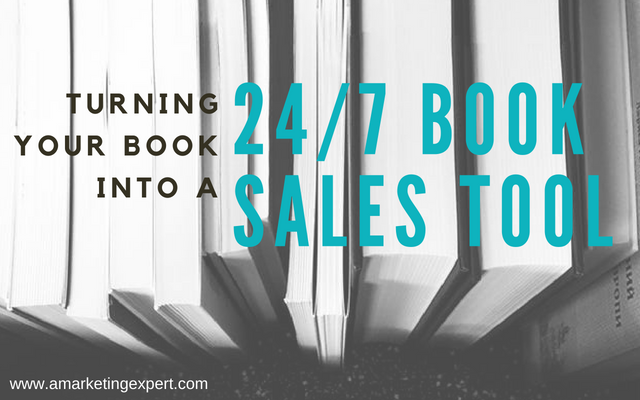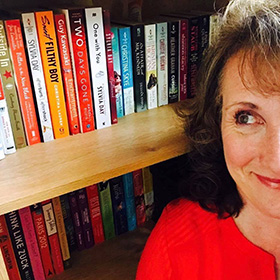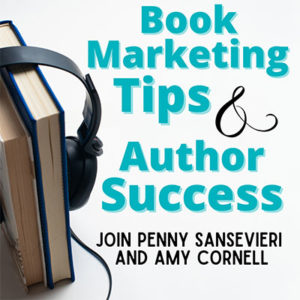Regardless of what type of book you’ve written, books need to work for you. Less than 3% of readers will review a book they’ve finished without any prompting. Meaning that if you don’t ask for a review, you’re likely not to get one. So what’s the solution to get more book reviews? Better book back matter. What does that mean? It means that your About the Author is good, but not great, a list of other books you’ve written is also good, but again probably not great. Your best book marketing goal is to get them to go from the experience of reading your book, to posting a book review or contacting you directly. And in turn, great back matter and a great reader letter will help you get more book sales.
The Power of the Reader-to-Author Connection
Several years ago Goodreads did a study and found that the number one thing that readers want to do at the end of a book is to connect with the author. Meaning that if you don’t make it easy for readers to reach you, you’re disappointing a potential fans and missing a big book marketing opportunity. So consider this when you’re putting together your reader letter.
Why a Letter to Readers Can Increase Book Sales
So what can a reader letter really do for you? Well, first off it brings readers to your doorstep. By inviting them to reach out to you, and politely asking for a book review. But it also goes further than that, because reviews are a great way to sell more books (people like what other people like) but it’s also a great way to build your newsletter list and gain direct access to your biggest fans. By adding fans to your mailing list, you now have a direct way to reach them when your next book comes out, or if you’re running a promotion or just to stay in touch in between book releases. The people who write you are your most ardent fans, these are the folks who will be the first to buy your books and may let their friends know about them, too.
Reader Letter in eBook, Print, or Both?
I tend to have more luck with the reader letter in an eBook, only because the live links either send readers to page I want them to visit, or pops open an email. But this will work in print, too. Just keep in mind that you don’t want too many links in the letter, because even for an eBook that’s too confusing.
Changing Up Your Reader Letter and Why You Should
A solid reader letter doesn’t have to be a static thing, in fact it’s probably better you’re your book marketing goals to switch it up now and then. Every so often, you may want to change up your reader letter to promote a new title, or mention something that’s happened (like an award you’ve won). In my non-fiction books, I use this letter to push readers to promotions or giveaways I’m doing, or to other, newer releases. If you do this, you’ll likely only focus on the eBook and it’s really simple to just swap out the letter and re-upload the book to Kindle or IngramSpark.
The Power of the Call-to-Action
You’ll hear the term call-to-action a lot in book marketing, also called CTA for short. If it’s used correctly, it’s a powerful way to get folks to take action. But there’s a catch. Most CTAs that I see aren’t really a call-to-action, instead they’re a rambling list of instructions with no clear message or focus. Having a reader letter in the back of your book is one thing, but having one that really encourages readers to take action, is another one altogether. So before we dig into the letter itself, let’s first look at the components of a good CTA:
- Choose one call to action: this is kind of a big deal, because you’re only allowed to have one “ask” however many authors, trying to be more aggressive in their book marketing, will list several requests. This only serves to confuse the reader, and they’ll take little to no action. So figure out what you want the reader letter to do, and make that a clear action statement in your letter.
- Keep it short and to the point: We don’t read, we scan, at this point in this blog post, you’ve maybe skipped over certain pieces or long paragraphs and that’s ok. We know that scanning is a “thing” it’s not just you, but keep in mind this means your reader does that, too. So don’t have a long, rambling letter with long paragraphs. If you do, it’s likely your reader will most the bulk of what you’re trying to say, or stop reading altogether. Book marketing 101 is to keep it simple and we’ll emphasize that more in the next point.
- Make it simple: I had an author once send me a reader letter that had all sorts of actions the reader needed to take to sign up for their mailing list. Which essentially means that unless the reader is your mother, they probably won’t do any of them. For any kind of marketing to work, especially book marketing, you need to direct them in specific, and easy ways. Whatever action you want folks to take, make it simple. Click here, is about the most you’ll want to ask of them and when they do click, make sure there isn’t a lot of work for them to do once they get to wherever you’re sending them. Or, you could just ask them to email you and you can manually add their email addresses to your newsletter. Or to your promo or whatever it is you’re inviting them to participate in.
- What’s in it for the reader? While the letter to readers is, clearly, all about your book marketing, it’s also about the reader so remember to make the benefits very clear. Even if it’s just asking for a review. Remind them how they are helping you. That you need their help. If it’s something else like a special offer, or a chance to win something, don’t belabor your “ask” with lots of words – just ask.
Here’s What a Good Reader Letter Can Do for Book Sales
One of our clients, a first-time, unknown author, was ready to her book marketing campaign. We knew that, given her genre, contemporary romance, the potential for receiving book reviews was low. We decided to encourage reviews by having her write a request letter to her readers at the end of her book. In her letter, she politely asked for feedback and a review. She now has over 300 reviews on Amazon. A letter to readers is really book marketing gold, and so often overlooked by authors.
Keep in mind, she was a first-time author with no online history—and she self-published. Even with all these things working against her, she got tons of book reviews. Were they all five-star? No, but let’s face it, a book page populated with tons of five-star reviews is often considered suspect anyway. All of her book reviews were authentic—written by real readers the author became engaged with. What’s more, these readers are now part of her “tribe.” She stays in touch with them and lets them know whenever another one of her books comes out.
For her second book, we encouraged her to actually write a letter explaining how tough it can be to get reviews and encouraging her readers to review her book(s) on Amazon and Goodreads. She also thanked them for buying her book.
The result was amazing. Here’s the sample letter but do note that the style of the letter should be revised on whether you are a fiction or nonfiction author. The goal of this letter was, quite specifically, to get more book reviews. I’ll also make some bolded notes, so you can see why the letter was written in this particular way.
Dear Reader,
Thank you for taking time to read Shelf Life: The Publicist, book 2. I sincerely hope you enjoyed it! I really love the characters Mac and Kate. Many readers wrote me asking, “What’s next for Nick?” Well, be sure to stay tuned, because the saga of publishing drama isn’t quite over. Nick will be back in book 3. Will he find his happy ending? I sure hope so.
**this first paragraph starts with a thank you, and then moves into mentioning the characters, which the author knew was important to the reader (because of the many emails she got about them).
When I wrote The Publicist, book 1, I got many letters from fans thanking me for the book. Some had opinions about Mac and Kate, while others rooted for Nick. As an author, I love feedback. Candidly, you’re the reason I will explore Nick’s future. So tell me what you liked, what you loved, even what you hated. I’d love to hear from you. You can write me at authorchristinageorge@gmail.com and visit me on the web at www.thepublicistnovel.com.
****In the above paragraph, she reminds readers why their voice is important and how the reader input is key to her decision making process when it comes to what she’ll write about next.
Finally, I need to ask a favor. If you’re so inclined, I’d love it if you would post a review of Shelf Life. Loved it, hated it—I’d just like to hear your feedback. Reviews can be tough to come by these days, and you, the reader, have the power to make or break a book. If you have the time, here’s a link to my author page, along with all my books on Amazon: http://amzn.to/19p3dNx
****This line pushes the importance of reviews, and is essentially the big ask or CTA of this letter. She also makes it easy, by including a simple link which is a link to her Amazon author page. This replaces the long list of “also authored” books that authors typically include in the back of the book.
Thank you so much for reading Shelf Life and for spending time with me.
In gratitude,
Christina George
The Benefits of Cross-Promotion
Another way to engage readers is to attract them from one book to the next. Generally, when you are reading a book on Kindle and you get to the end of the book, it will send you over to a page asking the reader to rate it, but also recommending other, similar books. One thing the Kindle device doesn’t do is send readers to the author’s Amazon page, where they can find out about the author’s other books. Kindle is in the business of selling books, so referring you to the “Also bought” page makes more sense for them, but it’s not true for you. Cross-promoting your books is an invaluable book marketing and sales strategy.
Other Ways You Can Cross-Promote Your Books
- If you really want to list your other titles at the back of your book you can, but you don’t want to overwhelm your reader. If you have too many, they likely won’t read through them. Instead, a good rule of thumb is to pick two or three, and vary which ones you mention in each of your books, meaning that in book X you reference titles A and B, and in book Y you mention books C and D. Readers generally glaze over long lists of books so limit their choices. Good book marketing really optimizes the “less is more” factor.
- Include a book excerpt or excerpts with the book mentions.
- Another fun idea to help enhance your book marketing is to create a special offer that links to your website or, ideally, takes them to a specific page on your website that presents this offer to them. Maybe as a thank-you give them a free download of one of your books or special reports. In exchange for this freebie, you get their e-mail address. This does two things: First, the freebie builds goodwill with your reader, and second, you’re collecting their e-mail for future promotions.
A Few Final Words About the Reader Letter
When it comes to book marketing, it’s tempting to want only great reviews. But you can’t ask for just good book reviews. Good or bad, you want reviews. Yes, I know some people may argue with me on this point but trust me when I say that you really want to avoid encouraging good book reviews. (Read this article to learn more about getting reviews from bloggers.)
Second, a lot of people may read this as an eBook, so be sure to put a live link in the book, preferably a link to your Amazon Author Central page . When you’re putting your book together, you won’t have the actual link to the Amazon page it’s on. And of course you want your readers to see all your books, not just the one they’re reading. Also, make sure your Amazon page is updated and current for more book sales. If you haven’t downloaded my new free quarterly Amazon planner yet to help you stay on top of it, click here to get it.
And be sure to add this reader letter to the last page of your book, not the front matter. A lot of authors like to write letters to their readers, but that’s not the purpose here. You want to thank them for reading a book they just finished. If your request is at the front, they’ll forget about it by the time they get to the end. Also, the algorithm in the Kindle reader is such that it defaults to the first chapter, thereby skipping all of the other content you have preceding that chapter.
Please let me know in the comments how your back matter has helped you with more book sales!





After reading this post, I am updating the reader letters in my ebooks…thank you! Linking Kindle readers to my Amazon Author page for reviews is ease, but where do I direct readers who purchased through Smashwords and Draft2Digital? With so many distribution points, does it make sense to ask readers to leave a review on my Amazon Author page, when they purchased the ebook at B&N or Kobo, etc.?
Cindy, I’m so glad that it’s helping you! That’s definitely something that’s up to you, and I think it really depends on where you’re getting the most book downloads, and where more readers are seeing your books. If you’re getting a lot of hits across the board, then you could certainly consider creating a different reader letter for each platform. If you do though, then remember you’ll have to update each one each time. Also, keep in mind that you can update your book description on just about any site with any great reviews you love, even if they’re not official reviews from that site. Let me know what you decide and how it works!
Thanks, Penny, I hadn’t thought of including reviews from one site on another. Great idea! My sales are scattered, so I opted for: “If you enjoyed Father, Son & Grace, please tell your friends. And if you could spare a few minutes to leave a review on your favorite ebook retailer’s site, or at Amazon.com, that would be awesome.” Amazon.com links to my sales page on Amazon. I will let you know what kind of response I get. Thank you again. 🙂
Fantastic, Cindy. I look forward to hearing how it goes!